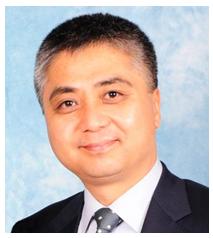
The promise of exoskeleton technology that would allow individuals with motor impairment to walk has been a challenge for decades. A major difficulty to overcome is that even though a patient is unable to control leg muscles, a powered exoskeleton could still cause muscle fatigue and potential injury.
However, an award from the National Science Foundation’s Cyber-Physical Systems (CPS) program will enable researchers at the University of Pittsburgh to develop an ultrasound sensor system at the heart of a hybrid exoskeleton that utilizes both electrical nerve stimulation and external motors.
Principal investigator of the 3-year, $400,000 award is Nitin Sharma, PhD, assistant professor of mechanical engineering and materials science at Pitt’s Swanson School of Engineering. Co-PI is McGowan Institute for Regenerative Medicine affiliated faculty member Kang Kim, PhD, associate professor of medicine and bioengineering. The Pitt team is collaborating with researchers led by Siddhartha Sikdar, PhD, associate professor of bioengineering and electrical and computer engineering at George Mason University, who also received a $400,000 award for the CPS proposal, “Synergy: Collaborative Research: Closed-loop Hybrid Exoskeleton Utilizing Wearable Ultrasound Imaging Sensors for Measuring Fatigue.”
This latest funding furthers Dr. Sharma’s development of hybrid exoskeletons that combine functional electrical stimulation (FES), which uses low-level electrical currents to activate leg muscles, with powered exoskeletons, which use electric motors mounted on an external frame to move the wearer’s joints.
“One of the most serious impediments to developing a human exoskeleton is determining how a person who has lost gait function knows whether his or her muscles are fatigued. An exoskeleton has no interface with a human neuromuscular system, and the patient doesn’t necessarily know if the leg muscles are tired, and that can lead to injury,” Dr. Sharma explained. “Electromyography (EMG), the current method to measure muscle fatigue, is not reliable because there is a great deal of electrical “cross-talk” between muscles and so differentiating signals in the forearm or thigh is a challenge.”
To overcome the low signal-to-noise ratio of traditional EMG, Dr. Sharma partnered with Dr. Kim, whose research in ultrasound focuses on analyzing muscle fatigue.
“An exoskeleton biosensor needs to be noninvasive, but systems like EMG aren’t sensitive enough to distinguish signals in complex muscle groups,” Dr. Kim said. “Ultrasound provides image-based, real-time sensing of complex physical phenomena like neuromuscular activity and fatigue. This allows Nitin’s hybrid exoskeleton to switch between joint actuators and FES, depending upon the patient’s muscle fatigue.”
In addition to mating Dr. Sharma’s hybrid exoskeleton to Dr. Kim’s ultrasound sensors, the research group will develop computational algorithms for real-time sensing of muscle function and fatigue. Human subjects using a leg-extension machine will enable detailed measurement of strain rates, transition to fatigue, and full fatigue to create a novel muscle-fatigue prediction model. Future phases will allow the Pitt and George Mason researchers to develop a wearable device for patients with motor impairment.
“Right now an exoskeleton combined with ultrasound sensors is just a big machine, and you don’t want to weigh down a patient with a backpack of computer systems and batteries,” Dr. Sharma said. “The translational research with George Mason will enable us to integrate a wearable ultrasound sensor with a hybrid exoskeleton, and develop a fully functional system that will aid in rehabilitation and mobility for individuals who have suffered spinal cord injuries or strokes.”
Read more…
University of Pittsburgh Swanson School of Engineering News Release
